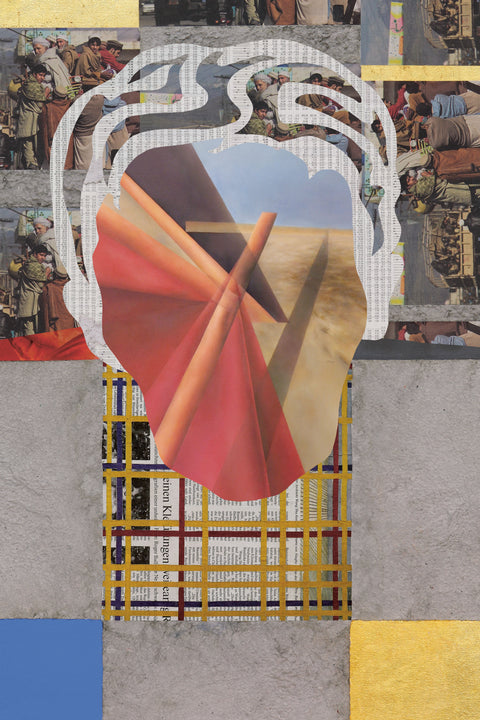
In Egypt, with the ten plagues and the drowning of Pharaoh’s army in the sea, the display of his destructive power is part of the logic of the narrative. His spectacles exhibit an excess of devastation that must have served some function. More than he sought to visit upon the people the wickedness of their deeds, to avenge sin and iniquity, he seems to have used his excess of power to stage an educational drama. Victims played an important role in this series of catastrophes: their suffering and agony allowed for his appearance; their beaten bodies were his form of materialisation. During the final show of that spectacular season, with the entire army – all Pharaoh’s horses, his chariots, and his horsemen drowning in the sea (Exodus 14:23) until there remained not so much as one of them (ibid. 14:28), the entire global community was swept with excitement, like an audience sitting in the balcony. The people heard, they trembled; sorrow shall take hold on the inhabitants of Palestina; then the chiefs of Edom shall be amazed; the mighty men of Moab, trembling shall take hold upon them; all the inhabitants of Canaan shall melt away (ibid. 15:14–15).
Following these events, his destructive power was directed almost solely against that group of freed slaves gradually turning into a people. The sovereign of all worlds became the sovereign of one special nation. Only now a true kingdom was founded and a real political community was formed. Prior to Egypt, the violence of destruction was not part of an act of political governance: he ruled the entire world, which he designed and created, but he governed nothing in it. It was only in the desert that he discovered the art of governance. It was there that he distinguished between his claim for mastery and ownership over the whole of creation and his claim to rule one, chosen people, together with the obligations that came with it. Only in the desert did his rule appear as properly political. Only there were laws given to mediate between the people’s deeds and his destructive potency; to protect them from his mighty rage and unrestrained fury. With the help of these laws, sins could be related to catastrophic punishment in a meticulous and systematic way. The eruption of his violence could be postponed and regulated, and his educational shows of horrors could become a means of governance.
 In the desert, his violence was gradually contained, using two new elements that had been missing before: law and time. When laws were given, law-abiding subjects could expect a certain degree of protection (though they could hardly help it if he chose to take revenge for their ancestors’ sins). More importantly, his eruptions of violence were seen as something that could be postponed, as something that belonged to a remote, indefinite future. Sinners should have expected the number of impending catastrophes to be truly colossal – in the long chapter 28 of Deuteronomy more than fifty possible kinds of disaster are patiently enumerated and vividly depicted – but the catastrophes are in the future. They were no longer part of the lived present, events people were going through in the here and now, but rather a mixture of memories of a remote past (Egypt, Sodom) and images of a distant future. This basic structure has been preserved in later apocalyptic writing, from the late prophets to the Revelation of St. John the Divine, when the remote, indefinite future became the end of time and the colossal catastrophe became doomsday. His name still designated a blend of violence and justice: his justice was related to sins, but his violence was a promise and a threat, not an actual exercise of force. With divine violence thus regulated, space was made for an independent economy of violence of which kings and emperors were the main but never the sole agents. They could act without being directly implicated in his scheme of destruction and mercy. At the same time, the door was left open for every calamity, whether natural or man-made, to be interpreted as a sign from heaven; as his message or signature. Only relatively late and very gradually was the link between God and disaster severed, and even in the most secularised societies it has never been severed completely. With every new calamity, voices emerge that try to explain it in terms of divine violence, the product of his rage and his design. And whenever such calamities appear, they compete with representations of the earthly economy of violence and with those who have stakes in its (at least relative) autonomy.
In the desert, his violence was gradually contained, using two new elements that had been missing before: law and time. When laws were given, law-abiding subjects could expect a certain degree of protection (though they could hardly help it if he chose to take revenge for their ancestors’ sins). More importantly, his eruptions of violence were seen as something that could be postponed, as something that belonged to a remote, indefinite future. Sinners should have expected the number of impending catastrophes to be truly colossal – in the long chapter 28 of Deuteronomy more than fifty possible kinds of disaster are patiently enumerated and vividly depicted – but the catastrophes are in the future. They were no longer part of the lived present, events people were going through in the here and now, but rather a mixture of memories of a remote past (Egypt, Sodom) and images of a distant future. This basic structure has been preserved in later apocalyptic writing, from the late prophets to the Revelation of St. John the Divine, when the remote, indefinite future became the end of time and the colossal catastrophe became doomsday. His name still designated a blend of violence and justice: his justice was related to sins, but his violence was a promise and a threat, not an actual exercise of force. With divine violence thus regulated, space was made for an independent economy of violence of which kings and emperors were the main but never the sole agents. They could act without being directly implicated in his scheme of destruction and mercy. At the same time, the door was left open for every calamity, whether natural or man-made, to be interpreted as a sign from heaven; as his message or signature. Only relatively late and very gradually was the link between God and disaster severed, and even in the most secularised societies it has never been severed completely. With every new calamity, voices emerge that try to explain it in terms of divine violence, the product of his rage and his design. And whenever such calamities appear, they compete with representations of the earthly economy of violence and with those who have stakes in its (at least relative) autonomy.
The relations between divine and earthly economies of violence underwent a significant transformation with the emergence of the modern state and its consolidation as a totality (of spaces, people, associations, etc.), a multi-apparatus that strives to control everything it contains and to contain everything it can control. On the one hand, the state has become a potential or actual generator and facilitator of large-scale disasters, and the destructive power of some states has been brought to perfection. On the other hand, the state has also become a facilitator, sponsor, and co-ordinator of assistance, relief and survival in times of disaster. In both cases, the state has taken, or might seem to be taking his role as the chief author of destruction and the ultimate agent of providence. This is one of the reasons for the persistence of political theology even in the most secular societies. Another is the fact that even when the modern state has taken His place, images of a destructive violence that encompasses the whole world, related to human deeds yet exceeding any human capacity to contain it, are still part of our collective memory and political imagination. These images are easily accessible, ready to be used and abused by the powers that be, as well as by those who oppose them. The chaotic space created by great calamities has always been and still is an arena for divine revelation.

One may think that when everyday life is acutely disrupted and one’s world seems to come to an end, a god is called for, not only to save the innocent but also to give meaning to meaningless events and to give sense to the incomprehensible. But if this is true, one can also think that such a god, who benefits from disruptions, may even need them in order to reveal himself, to be imagined, to make sense.
States that tend to imitate God benefit from disasters for the same reason, even when they cannot claim to be their authors, because any such disaster may serve as a pretext for declaring a state of emergency, thus reclaiming and reproducing the state’s total authority. And when earthly powers imagine that they can take His place in the divine economy of violence, faith may provide resistance but no shelter. It is not God’s response to human sins but sheer human hubris that might bring the world to its end.
Excerpt from 'Divine Violence' by Adi Ophir, from The Holy Bible by Adam Broomberg and Oliver Chanarin.

Embossed leather flexibound
22 x 17 cm, 768 pages
First edition, first printing
£400
Add to cart
First edition, second printing
£200
Add to cart





